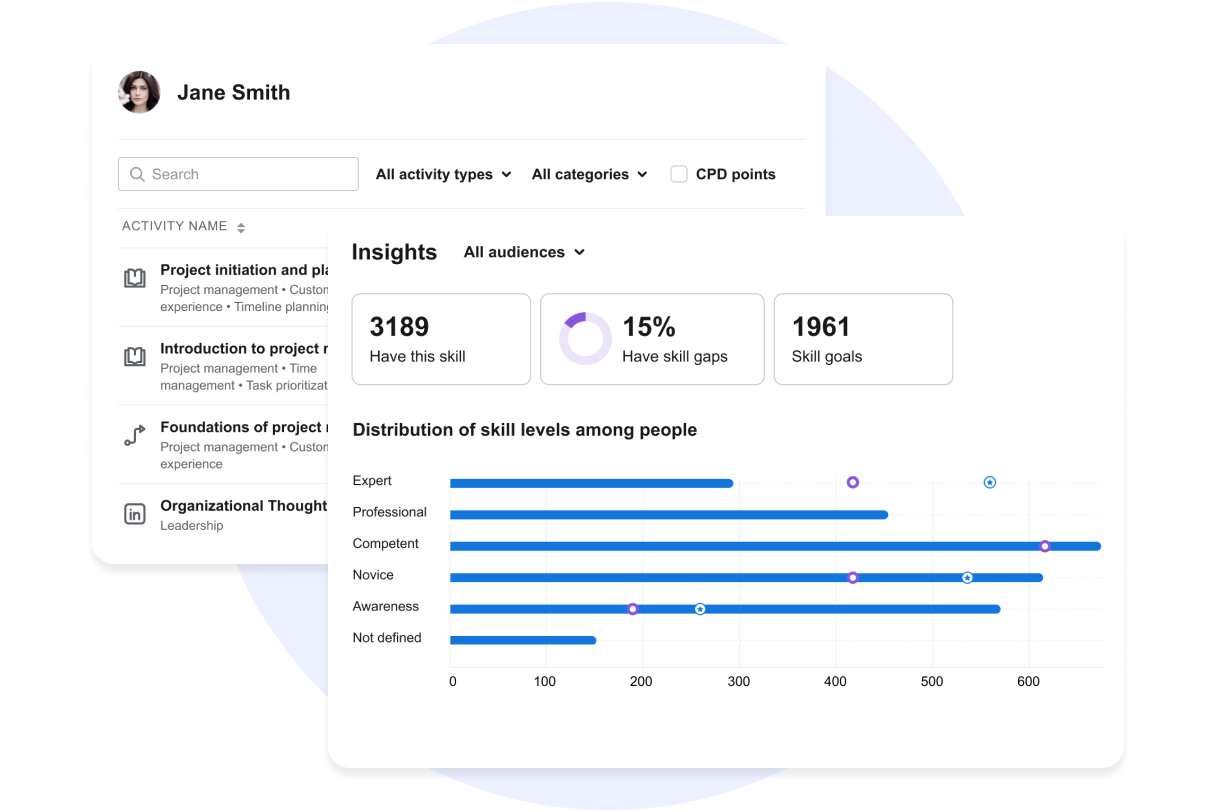Performance management process
What are the performance management process steps? Learn how to organize the performance management process with step by step instructions.

Discover:
What is the performance management process?
The performance management process is a collaborative, communication-based process where employees and management work together to plan, monitor and review the employee’s objectives, long-term goals, job trajectory and comprehensive contribution to the company.
This process is continual, with regular sessions where both management and employees have the opportunity to give and receive feedback.
According to the Gallup State of the American Workplace study, only 22% of employees are engaged and thriving. Employees who are engaged and thriving are more likely to maintain strong work performance, even during difficult times.
This also means that 78% of the workforce could do better work if only their organization had the right type of management process.
Some reasons cited in this study for lack of motivation are seeing less deserving employees receive promotions, lack of actionable feedback, and management not involving employees in goal setting.
All of these taken together show the importance of the performance management process, and why each part of it must be done well for the process as a whole to succeed.
The performance management process, when done correctly, is designed to fix those problems in the workplace, setting employees up for success in achieving both their goals and overall company objectives.
Performance management process steps
The steps in the performance management process can be broken down into four broad categories: Planning, coaching, reviewing and rewarding.
Each step is equally important, and together form the backbone of a company’s performance management process.
1. Planning
The first step of the performance management process is Planning.
1.1 The defining stage
The performance management process begins with the planning stage.
HR and management need to define the job itself, including a comprehensive description, long and short-term goals, identify key objectives and develop a clear metric for how those objectives and goals will be assessed.
Goals should be clear, done in the SMART format (specific, measurable, attainable, relevant, time-based) and clear performance standards should be set.
1.2 The feedback stage
Once management has completed the defining stage, employees should have the opportunity to give input on this material. They are the one doing their job and will have a key insight into what skills, competencies and goals will best assist the company to achieve organizational goals.
1.3 The approval stage
Management and employees both agree to the definition of the role, goals and objectives.
By making this first step of the performance management process collaborative, management sets the stage for the process as a whole to be collaborative, and the employee feels that they are involved in goal setting – an important thing, as evidenced by the Gallup study.
1.4 Organizational goal setting
This step involves aligning individual and team objectives with the overall goals of the organization. Clear alignment ensures that all efforts contribute towards the company’s strategic vision.
2. Coaching
2.1 Organize meetings on a timely, regular basis
Once the parameters of the job and objectives for the future have been set, the next step of the performance management process begins.
The coaching process is extremely important and must be done on a regular basis. Meetings should be at least quarterly, although monthly meetings are the ideal.
2.2 Provide necessary training, coaching and solutions
These meetings should focus on solutions and coaching opportunities, rather than punitive measures for lackluster performance.
If accountability is made into a negative, then employees will avoid it rather than being honest about where they are struggling.
In some cases, management training in this area can be very helpful to an organization.
2.3 Solicit feedback on both sides
Management should be able to give – and receive – honest feedback and work with employees rather than adopting a combative stance.
The ability to give actionable feedback is important here.
2.4 Revisit objectives as necessary
As the performance management process continues, management should revisit objectives to see if adjustments should be made, as well as pay attention to career development opportunities for their employees.
This step involves reviewing the overall performance of the employee, how well the process itself worked, and it also includes the reward – which is an extremely important part of the overall process.
2.5 Continuous monitoring
Use tools like KPIs and performance dashboards to provide real-time insights into employee progress. Regular check-ins and feedback sessions help address issues promptly and keep employees on track.
3. Reviewing
3.1 Reviewing employee performance
At the end of the yearly performance management cycle, there should be an employee review, which is sometimes also called a performance appraisal. Typically, these are held once a year, to look at how well the employee performed over that span of time.
There should be a clear record from previous check-ins to show the employee’s progress throughout the year. The monthly check-ins are to help the employee with problem-solving, adjusting goals and other future-looking tasks. This performance review is the only step that looks backward, to assess the behavior of the past year.
3.2 Reviewing the performance management process
At this stage, it is important for both management and employees to look over the previous year and see how well the performance management process worked.
Questions that can be asked are:
- Were personal and organizational objectives met? If not, why?
- What challenges did the employee face?
- What training would help the employee perform better?
- How did management feedback help? If not, why?
- How could the process be made better?
- Was the time spent on this process effectively?
3.3 Reviewing overall goal completion
Of course, one of the main questions to answer is ‘did the employee reach their goals?’ How well did the employee succeed at the tasks given to them throughout the year?
It is important to look at both smaller and larger goals, as this can give an indication to problem areas where training or interventions can be applied.
3.4 Giving actionable feedback
A key part of the review is to give and receive feedback.
Management should give actionable feedback for the employee so that they know areas where they can improve future performance.
The employee should also be invited to give feedback on the process, and how management can do better on their end.
3.5 Development plans
Create personalized development plans that focus on skill enhancement and career growth. These plans should be revisited regularly to ensure they remain aligned with both personal and organizational goals.

Career development plan template
This template helps employees and leaders plan together for career growth: set goals, assess skills, and make a plan.
Download now4. Action
And the final step in performance management process is Action.
4.1 Reward and recognition
The last step of the performance management process is the reward and recognition.
This step is absolutely key – employees will not stay motivated if they are given no reason to. This does not necessarily have to be monetary, although it likely will include monetary compensation. Other rewards could be new projects, company-wide recognition, time off, or leadership opportunities.
4.2 Setting the stage for next year’s performance management cycle
The end of the performance management cycle gives management and employees one last chance to offer feedback on the process as a whole and asks for thoughts and feedback for the planning stage for the next year’s cycle.
4.3. Technological integration
Recommend the use of performance management software to streamline the process. Software can help in tracking goals, managing employee records, and providing a platform for continuous feedback and coaching.
Additionally, if the organization has a modern Learning Management System (LMS), like Valamis, it can be integrated to support ongoing employee development and training initiatives.

The example of skills and completions reports at Valamis that can help to analyze employee learning progress and identify gaps in training programs, ensuring targeted and effective development initiatives
4.4. Comprehensive reward strategies
Detail various reward strategies beyond monetary compensation, such as public recognition, leadership opportunities, and additional responsibilities. This motivates employees by recognizing their efforts and contributions in diverse ways




